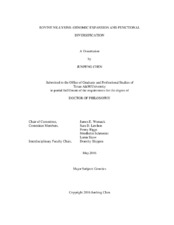| dc.description.abstract | NK-lysin is a cationic antimicrobial peptide (AMP) of the host innate immune system and active against a broad spectrum of targets, including bacteria, viruses, fungi and cancer cells. NK-lysin has been well-studied in humans and pigs, in which each genome contains a single copy of NK-lysin. However, the bovine genome has received much less attention with only one study, in which two 405-bp Bo-lysin fragments with 94% nucleotide identity were detected among four experimental donors. These two sequences likely represent two different bovine NK-lysin genes. The purpose of the present study was to characterize the gene number and the genomic organization of bovine NK-lysins and their roles in host resistance to pathogens, including pathogens involved in bovine respiratory diseases (BRD).
Two overlapping BAC clones (CH240-372P1 and CH240-27G22) covering the whole bovine NK-lysin region were sequenced by PacBio (Seattle, WA) and the assembled supercontig revealed four NK-lysin genes on cattle chromosome 11. NK2A, NK2B and NK2C are tandemly arrayed as three copies in 30 ~ 35 Kb segments, located 41.8 Kb upstream of NK1. All four genes are functional, albeit with differential tissue expression. NK1, NK2A and NK2B exhibited the highest expression in intestine Peyer’s patch while NK2C was expressed almost exclusively in lung. Four peptides corresponding to the functional helices 2 & 3 of each gene product were synthesized. Circular dichroism (CD) spectroscopy demonstrated that peptides adopted a more helical secondary structure upon binding to an anionic model membrane, and a liposome leakage assay suggested that these peptides disrupt the model membrane. To test the potential role in host response to BRD pathogens, we analyzed RNA-seq data to determine expression of each NK-lysin gene in bronchial lymph node and lung in healthy animals and animals challenged with BRD pathogens. The expression of some NK-lysins, especially NK2C, was significantly elevated in most of the challenged animals, indicating potential functions in BRD resistance. Antimicrobial effects of the synthetic peptides against Escherichia coli, Staphylococcus aureus, Pasteurella multocida and Mannheimia haemolytica were further confirmed with bacterial killing assays, and their lytic influences on cell membranes were confirmed by transmission electron microscopy (TEM). | en |


